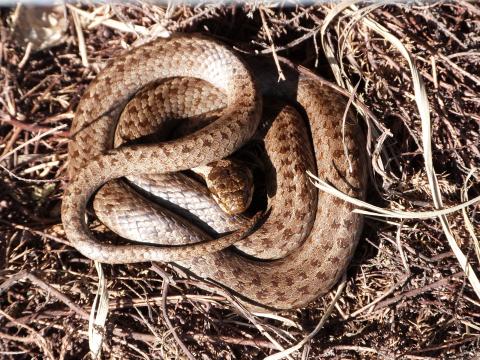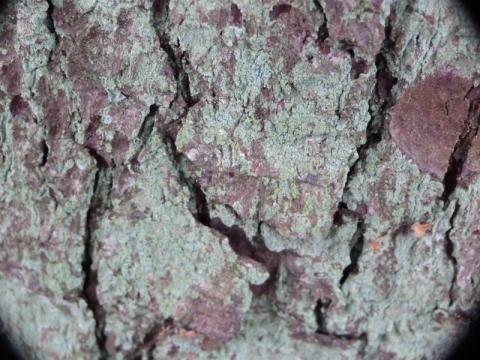The black darter (Sympetrum danae) is a dragonfly of the heath and moorland; it favours acidic boggy waters and whether that be bog pools, ditches, or whatever does not seem to matter as long as sphagnum mosses are present. With this as its main habitat it is not surprising that the Dorset heaths are a good place to find this particular insect. It can be seen flying from July through until October. It is a very active dragonfly, darting here and there around its patch. It is not one of the more territorial species, far more interested in looking a mate than a fight with another male. They rest in cool conditions on stones and bare ground and can even be found on warm cow pats as they try to acquire heat to enable them to become active. The black darter is the smallest dragonfly found in Britain. The male is very handsome insect; black with yellow markings! That said, the female in her golden brown dress is pretty tasty too in my opinion, but then I like dragonflies!
Month: March 2015
Song Thrush: the herald of spring
Even before we get to the shortest day in mid-winter and when all birds, other than the robin, are quiet somehow the song thrush (Turdus philomelos) will be able to tell better times are ahead. It will perch high in a tree and proclaim to anyone who will listen that the darkening days are almost behind and the corner towards spring is about to be turned. The robin is the sole singer (or is it the ‘soul’ singer with that plaintiff winter song?) for the previous three months but gradually the song thrush joins in. With its clear melodious phrases it is a true herald of the coming of spring. Once upon a time the song thrush was common in gardens but in recent years the numbers have crashed and now it ranks number 17 in the garden bird league table when thirty years ago it was number 10. Fortunately the decline of this species does seem to have stalled and the population stabilised and one hears them quite often out in the countryside but they are still only very occasional visitors to gardens. Song thrushes are lovely birds with seemingly a very gentle nature and are easily bullied and seen off by their more aggressive cousin, the blackbird.
Wild Strawberry: the woodland strawberry
April through to July is the time to look for the wild strawberry (Fragaria vesca). The fruit it produces is very similar to the garden strawberry we all love to eat only much smaller and, inevitably, the flower is smaller too. it can easily confused with the barren strawberry which is very similar but that flowers earlier from February through to May and is has blueish leaves whereas the wild strawberry has shiny green leaves. Also known as the wild strawberry, it is common in woodland where there is plenty of light so it is mainly found on sunny banks, rides and glades. It can also be found out of woodland in hedgerows, on embankments and even along roadsides across Dorset. The fruit of the wild strawberry was once popular with humans but as larger fruiting varieties were developed for cultivation and cropping so the wild strawberry became somewhat ignored despite being very tasty.
Lichen: Lecidella elaeochroma
I always think that this lichen, Lecidella elaeochroma, looks like a child has been drawing with a pencil on the bark of the tree (purely as my drawing ability is so poor and it looks my attempt at drawing but I would not want anyone to know!). These lichen form a crust on the bark of a tree and have blackish edges which merge together to form a larger mass giving the impression of continuous wiggly lines. In the centre of each distinct area there are black specks, some more pronounced than others. This is quite a common in south western Britain if you take the trouble to look for it! It grows on all kinds of trees and also on fences but it shows up best on the light coloured, smooth bark of willows and sallow as well as on silver birch.
Lesser Black-backed Gull: less black on the back
Amongst the more common gulls we have all year round here in Dorset (great black-backed, herring and black-headed) we get a number of other visitors from the family. The lesser black-backed gull (Larus fuscus) is not an uncommon species in winter around our shores, and it is always worth having a closer look at any gull with a dark back to see if it is ‘lesser’ rather than ‘greater’. As you might expect, the lesser black-backed gull is smaller than the greater and the lesser’s back is less black than the greater’s. The lesser black-backed gull is a very close relative of the herring gull, it is the same size, has similar legs and beak (including the red patch) and in many ways is just a herring gull with a dark back. Here in the south of England the herring gull is much more common but as you head north so the lesser black-backed gull takes over.
Moschatel: the town hall clock
 Spring in deciduous woodlands, before the leaf canopy forms and darkens the woodland floor, is a time when the most flowering plants can be found in this habitat. Many only grow in such woodland and are often indicators that the wood itself has been continuously present on that site for many hundreds of years. One such flower is moschatel (Adoxa moschatellina), the only member of the adoxaceae family in the whole world. Moschatel forms carpets of green, five lobed leaves. From amongst these leaves the flower stems rise up and at the top of each stem five small greenish yellow flowers form; one points upwards and the other four face outwards at right angles to each other like the four faces of a clock tower which is the origin of its familiar name, the town hall clock. The flowers produce a musk-like scent in the evening, “musk-at-el”. Not uncommon in well established broad-leaved woodland but easily overlooked unless you know what you are looking for so keep an eye for the small, town hall clock flowers.
Spring in deciduous woodlands, before the leaf canopy forms and darkens the woodland floor, is a time when the most flowering plants can be found in this habitat. Many only grow in such woodland and are often indicators that the wood itself has been continuously present on that site for many hundreds of years. One such flower is moschatel (Adoxa moschatellina), the only member of the adoxaceae family in the whole world. Moschatel forms carpets of green, five lobed leaves. From amongst these leaves the flower stems rise up and at the top of each stem five small greenish yellow flowers form; one points upwards and the other four face outwards at right angles to each other like the four faces of a clock tower which is the origin of its familiar name, the town hall clock. The flowers produce a musk-like scent in the evening, “musk-at-el”. Not uncommon in well established broad-leaved woodland but easily overlooked unless you know what you are looking for so keep an eye for the small, town hall clock flowers.
Keeled Skimmer: on an even keel
The keeled skimmer (Orthetrum coerulescens) is a specialist of wet heathland and bog, especially in areas where sphagnum mosses thrive. As a result the heathland areas of Dorset are one of its strongholds in this country and it is, nationally, quite rare. Where it does occur, however, it can be abundant. Easily dismissed at first sight as a broad-bodied chaser because of its bright blue body (the male that is) closer examination, if it settles, will show a narrower body tapering to a point at the tail. It also lacks the yellow side markings on the abdomen. The keeled skimmer tends to fly low over the water of its chosen pond, skimming over it in fact. It has a rapid and unpredictable flight pattern, usually near the edge of the water, where the pond side vegetation grows. The male settles on a favoured perch to monitor activity on their patch but show interest in intruders rather than out right confrontation, unlike the aggressive broad-bodied chaser. The females are green and have a thin, less tapered body.
Smooth Snake: a real smoothie
All of our three native British species of snake are now scarce to say the least but the smooth snake (Coronella austriaca) is nationally rare. In Dorset, however, thanks to the large area of remaining lowland heath which is now a protected habitat they are actually quite well established. Despite this they are rarely seen as they are very shy and secretive creatures and you are very fortunate if you encounter one. It is a small, slender snake with what I consider to be a very gentle face! They are not, however, gentle creatures and are quite capable of killing lizards and slow-worms as part of their diet. They are constrictors squeezing their victim to death before swallowing them whole. They are not venomous and are totally harmless to human beings. As their name implies, their skin is smooth to touch as the scales lie flat and this, as well as their size and pale brown blotched skin, tells them apart from the other two species. That said, they are a protected species and should not be handled without a licence to do so as they need to be treated with care to avoid injury. It is such a shame many people dislike, or are even frightened of, snakes. They are truly awesome animals in my view.
Lords and Ladies: the name game
Lichen: Lecanora conizaeoides
This is a lichen everyone will have seen but only those with a particular interest will have taken any notice of or given any thought to! Not only is it totally insignificant to look at it has a very difficult name to say, let alone remember, it is Lecanora conizaeoides. This lichen does not look like anything other than some boring, crusty, possibly mouldy skin but it is, indeed, a lichen and is probably our most common lichen at that. It can be found primarily on tree bark and it is probably most notable on oak trees; there can hardly be an oak tree in Dorset that does not bear some of this lichen on it somewhere. It does also occur on walls, rocks and even soil. This was once a quite rare species but during the course of the twentieth century it became one of the most common as it is totally impervious to sulphur dioxide and so thrives in polluted areas where it has replaced other lichen that have dwindled.









